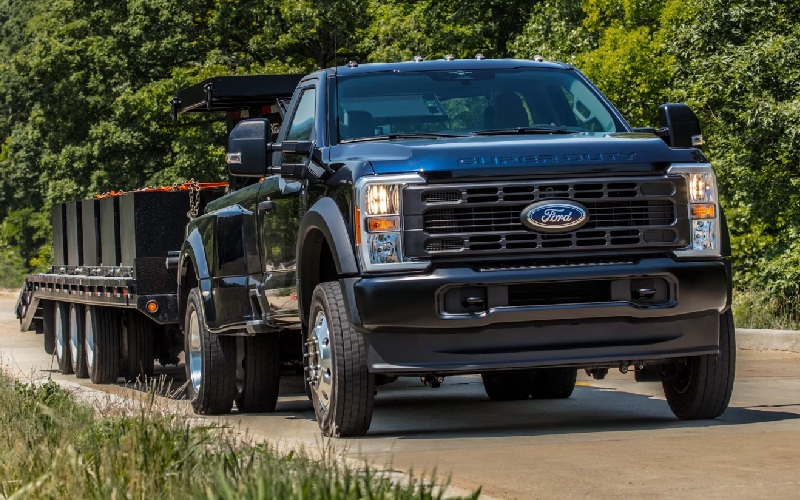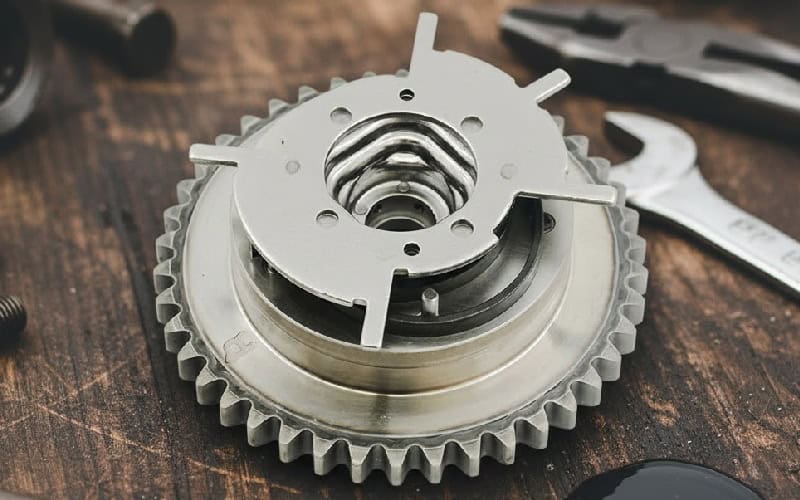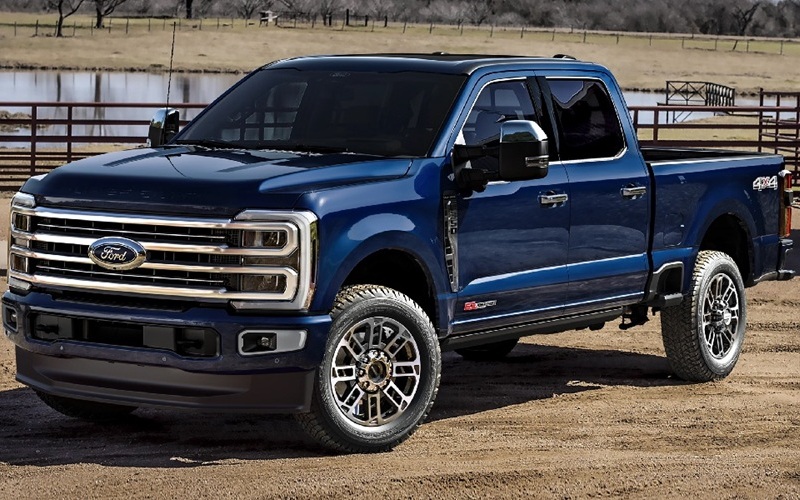The Ford F-450 Super Duty brake master cylinder stands as a critical component in one of Canada’s most capable heavy-duty trucks. This essential part transforms the mechanical force applied to the brake pedal into hydraulic pressure that activates the braking system throughout the vehicle. With its robust construction and precision engineering, the master cylinder ensures reliable stopping power when hauling heavy loads or navigating challenging terrain across the Canadian landscape.

The Brake Master Cylinder
The brake master cylinder serves as the command center for your entire F-450 braking system. Located on the firewall of the engine compartment and connected to the brake pedal via the brake booster, this component contains a fluid reservoir and precision-machined cylinders that generate the hydraulic pressure needed to operate the brakes.
When you press the brake pedal, the master cylinder pushes brake fluid through the lines to the callipers and wheel cylinders, creating the pressure necessary to slow or stop your Super Duty truck. The quality and condition of this component directly impact braking performance, response, and safety.
Technical Specifications
Ford F-450 Super Duty trucks utilize different master cylinder specifications depending on the model year and braking system configuration. Most models feature either a 1.3125-inch (33.3 mm) or 1.50-inch (38.1 mm) bore diameter. The larger bore size provides additional hydraulic force required for the heavier applications typical of Super Duty operations.
The master cylinder works in conjunction with either a vacuum or hydraulic booster. Vacuum-boosted systems are common on gasoline engine models, while diesel-powered F-450s typically use hydraulic boost for enhanced braking assistance, especially under heavy load conditions.
Design Evolution and Improvements
Throughout the generations of the F-450 Super Duty, Ford has continuously refined the master cylinder design to enhance performance, reliability, and safety. Early models from the early 2000s featured simpler configurations, while newer versions incorporate advanced materials and precision manufacturing techniques.
The Ford engineering team has paid particular attention to the internal components, including the primary and secondary pistons, seals, and valves. These refinements have resulted in more consistent brake pedal feel, improved response under various conditions, and enhanced durability in the demanding Canadian climate.
Maintenance and Care
Proper maintenance of your F-450 brake master cylinder starts with regular brake fluid checks and changes. Ford recommends checking the fluid level during regular service intervals and changing the fluid completely every two years or 48,000 kilometres, whichever comes first.
Brake fluid absorbs moisture over time, lowering its boiling point and potentially causing internal corrosion of the master cylinder and other brake components. This is especially important in Canadian climate conditions, where humidity and temperature extremes can accelerate fluid degradation.
When checking the fluid reservoir, look for a clean, amber-colored fluid. Dark, cloudy, or contaminated fluid indicates it’s time for a change. Always use the recommended DOT-rated brake fluid specified in your owner’s manual to ensure compatibility with the system’s seals and components.
How to Fix Common Issues
The master cylinder’s function is critical to safe vehicle operation. Common problems include internal seal deterioration, which can cause fluid to bypass the pistons. This typically manifests as a sinking brake pedal or reduced braking effectiveness.
External leaks may appear as fluid dripping or accumulating around the master cylinder, brake booster connection, or reservoir. Any sign of fluid loss requires immediate attention, as it affects braking performance and safety.
Another issue particular to the F-450 in Canadian environments is damage from road salt and extreme temperatures. The constant cycling between freezing and thawing can accelerate wear on seals and internal components, making regular inspection essential.
Upgrade and Replacement Considerations
When replacing the master cylinder on your F-450 Super Duty, always select components that match or exceed the original equipment specifications. While aftermarket options are available, genuine Ford replacement parts ensure proper fit, function, and compatibility with other brake system components.
For those who’ve modified their F-450 with larger tires, heavier accessories, or who regularly tow near maximum capacity, consulting with a brake specialist about potentially upgrading to a master cylinder with appropriate specifications might be beneficial. This ensures that braking performance remains strong even under the most demanding conditions.
The Integration with Advanced Braking Systems
The F-450 Super Duty’s master cylinder works in concert with advanced braking technologies, including anti-lock braking systems (ABS) and electronic stability control. These systems rely on proper master cylinder function to deliver consistent hydraulic pressure during emergency situations.
The integration between these systems highlights the importance of maintaining the master cylinder to factory specifications. When functioning properly, this integrated approach provides F-450 owners with confident braking performance whether navigating icy mountain passes or bringing heavy loads to a controlled stop.
Ford F-450: Power and Safety
The brake master cylinder might not be the most visible component on your Ford F-450 Super Duty, but it remains one of the most critical for safe operation. Understanding its function, maintenance requirements, and signs of potential issues empowers owners to properly maintain this essential safety system.
For F-450 owners traversing Canada’s diverse and sometimes challenging terrain, a properly functioning master cylinder provides peace of mind and reliable performance. Whether hauling heavy loads through British Columbia’s mountain passes or navigating Ontario’s busy highways, this often-overlooked component deserves attention and care to ensure your Super Duty delivers the stopping power you expect when you need it most.
Facts About the F-450 Super Duty Brake Master Cylinder
1. Dual-Circuit Safety Design: The F-450 master cylinder features a dual-circuit design that separates the front and rear braking systems. This safety-critical feature ensures that if one circuit fails, the other remains operational, providing approximately 70% of normal braking power—enough to bring the vehicle to a controlled stop.
2. Temperature Compensation Engineering: Ford engineered the F-450 master cylinder with special compensating ports and valves that account for brake fluid expansion due to temperature changes. This design prevents brake drag in extreme Canadian winter conditions when fluid contracts and expands with temperature fluctuations.
3. Specialized Alloy Construction: The master cylinder housing is crafted from a specialized aluminum alloy that offers superior corrosion resistance against road salt and chemicals commonly used on Canadian roads while maintaining excellent heat dissipation properties.
4. Integration with Advanced Driver Assistance: On newer F-450 models, the master cylinder works in conjunction with the electronic stability control and anti-lock braking systems through specialized pressure sensors that continuously monitor hydraulic pressure within the braking system.
5. Evolutionary Bore Sizing: Ford engineers precisely calculate the master cylinder bore size for each F-450 configuration based on gross vehicle weight rating, tire size, and intended use. This optimization ensures optimal pedal feel and braking performance, whether the truck is used for snowplowing in Saskatchewan or hauling equipment in the Alberta oil fields.
Common Questions About the F-450 Super Duty Brake Master Cylinder
How does the brake master cylinder work in the Ford F-450 Super Duty?
- The master cylinder converts the mechanical force from your foot pressing the brake pedal into hydraulic pressure. When you press the pedal, it pushes a piston in the master cylinder, forcing brake fluid through the lines to the callipers and wheel cylinders. This hydraulic pressure causes the brake pads to clamp against the rotors, slowing or stopping the vehicle. This heavy-duty truck system utilizes a dual-circuit design for redundancy and safety.
What are the signs that the master cylinder is failing?
- Warning signs include a spongy or soft brake pedal, a brake pedal that slowly sinks to the floor when held down, uneven braking performance, contaminated brake fluid (dark or rusty appearance), visible fluid leaks near the master cylinder or brake booster, and illuminated brake warning lights on the dashboard. Any of these symptoms warrants immediate inspection by a qualified technician.
How often should the master cylinder be replaced on a Ford F-450?
- Unlike typical wear items such as brake pads, the master cylinder doesn’t have a predetermined replacement interval. With proper maintenance, it can last 160,000 to 240,000 kilometres. However, the service life depends on driving conditions, maintenance practices, and brake fluid quality. Regular inspection during brake service is the best approach to determine when replacement is necessary.
What type of brake fluid does the F-450 Super Duty master cylinder use?
- Super Duty vehicles typically require DOT 3 or DOT 4 brake fluid, depending on the model year. Always consult your owner’s manual for the exact specification. It’s crucial never to mix different types of brake fluid, as this can cause damage to seals and components within the brake system.
Can I rebuild my F-450 master cylinder instead of replacing it?
- While master cylinder rebuild kits are available, most professional mechanics recommend complete replacement with a new or remanufactured unit. This approach ensures proper function and safety, especially in a heavy-duty application, where braking performance is critical. Modern master cylinders incorporate precise internal components that are difficult to properly service outside a specialized facility.
Is the master cylinder different on diesel versus gasoline F-450 models?
- Yes, there are differences. Diesel-powered models typically utilize a hydraulic brake booster system that works with the power steering pump to generate assist force, while gasoline models often use a vacuum brake booster. This affects the master cylinder configuration and mounting. Additionally, the master cylinder bore size may differ between engine options to accommodate the vehicle’s weight and braking requirements.
Disclaimer: Content contained in this post is for informational purposes only and may include features and options from US or international models. Please contact the dealership for more information or to confirm vehicle, feature availability.





